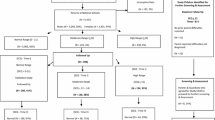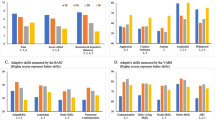Abstract
There is a lack of instruments validated for screening of autism spectrum disorders (ASD) in general populations and primary care settings. The Autism Spectrum Screening Questionnaire (ASSQ) has previously been shown to have good screening properties in clinical settings. We used the ASSQ to screen a total population of 7–9 year-olds (N = 9430) for ASD in the Bergen Child Study. Parents and teachers filled in the ASSQ, and high-scorers were invited for clinical assessment, along with a large group of screen negative children. We found that the ASSQ was well suited as a general population screen. Combining parent and teacher ASSQ and using cut-off score of ≥17 provided the most efficient screen with sensitivity of 0.91 and specificity of 0.86.



Similar content being viewed by others
References
Achenbach, T. M., McConaughy, S. H., & Howell, C. T. (1987). Child/adolescent behavioral and emotional problems: Implications of cross-informant correlations for situational specificity. Psychological Bulletin, 101(2), 213–232. doi:10.1037/0033-2909.101.2.213.
Allison, C., Williams, J., Scott, F., Stott, C., Bolton, P., Baron-Cohen, S., et al. (2007). The Childhood Asperger Syndrome Test (CAST): Test–retest reliability in a high scoring sample. Autism, 11(2), 173–185. doi:10.1177/1362361307075710.
American Psychiatric Association. (2000). Diagnostic and statistical manual of mental disorders (4th ed., Text Revision). Washington, DC: American Psychiatric Association.
Baird, G., Simonoff, E., Pickles, A., Chandler, S., Loucas, T., Meldrum, D., et al. (2006). Prevalence of disorders of the autism spectrum in a population cohort of children in South Thames: The Special Needs and Autism Project (SNAP). Lancet, 368(9531), 210–215. doi:10.1016/S0140-6736(06)69041-7.
Bilenberg, N., Petersen, D. J., Hoerder, K., & Gillberg, C. (2005). The prevalence of child-psychiatric disorders among 8–9-year-old children in Danish mainstream schools. Acta Psychiatrica Scandinavica, 111(1), 59–67. doi:10.1111/j.1600-0447.2004.00432.x.
Bolton, P., Macdonald, H., Pickles, A., Rios, P., Goode, S., Crowson, M., et al. (1994). A case-control family history study of autism. Journal of Child Psychology and Psychiatry, and Allied Disciplines, 35(5), 877–900. doi:10.1111/j.1469–7610.1994.tb02300.x.
Clark, A., & Harrington, R. (1999). On diagnosing rare disorders rarely: Appropriate use of screening instruments. Journal of Child Psychology and Psychiatry, 40(2), 287–290.
Ehlers, S., & Gillberg, C. (1993). The epidemiology of Asperger syndrome. A total population study. Journal of Child Psychology and Psychiatry, and Allied Disciplines, 34(8), 1327–1350. doi:10.1111/j.1469-7610.1993.tb02094.x.
Ehlers, S., Gillberg, C., & Wing, L. (1999). A screening questionnaire for Asperger syndrome and other high-functioning autism spectrum disorders in school age children. Journal of Autism and Developmental Disorders, 29(2), 129–141. doi:10.1023/A:1023040610384.
Ehlers, S., Nyden, A., Gillberg, C., Sandberg, A.D., Dahlgren, S.O., Hjelmquist, E., et al. (1997). Asperger syndrome, autism and attention disorders: a comparative study of the cognitive profiles of 120 children. Journal of Child Psychology and Psychiatry, and Allied Disciplines, 38(2), 207–217. doi:10.1111/j.1469-7610.1997.tb01855.x.
Fombonne, E. (2003). Epidemiological surveys of autism and other pervasive developmental disorders: An update. Journal of Autism and Developmental Disorders, 33(4), 365–382. doi:10.1023/A:1025054610557.
Gillberg, C., & Wing, L. (1999). Autism: Not an extremely rare disorder. Acta Psychiatrica Scandinavica, 99(6), 399–406. doi:10.1111/j.1600-0447.1999.tb00984.x.
Goodman, R., Ford, T., Richards, H., Gatward, R., & Meltzer, H. (2000). The development and well-being assessment: Description and initial validation of an integrated assessment of child and adolescent psychopathology. Journal of Child Psychology and Psychiatry, and Allied Disciplines, 41(5), 645–655.
Hanley, J. A., & McNeil, B. J. (1982). The meaning and use of the area under a receiver operating characteristic curve. Radiology, 143(1), 29–36.
Haynes, R. B., Sackett, D. L., Guyatt, G. H., & Tugwell, P. (2006). Clinical epidemiology (3rd ed.). Lippincott Williams & Wilkins.
Heiervang, E., Stormark, K. M., Lundervold, A. J., Heimann, M., Goodman, R., Posserud, M. B., et al. (2007). Psychiatric disorders in Norwegian 8- to 10-year-olds: An epidemiological survey of prevalence, risk factors, and service use. Journal of the American Academy of Child and Adolescent Psychiatry, 46(4), 438–447. doi:10.1097/chi.0b013e31803062bf.
Honda, H., Shimizu, Y., & Rutter, M. (2005). No effect of MMR withdrawal on the incidence of autism: A total population study. Journal of Child Psychology and Psychiatry, and Allied Disciplines, 46(6), 572–579. doi:10.1111/j.1469-7610.2005.01425.x.
Hughes, C., Soares-Boucaud, I., Hochmann, J., & Frith, U. (1997). Social behaviour in pervasive developmental disorders: Effects of informant, group and “theory-of-mind”. European Child & Adolescent Psychiatry, 6(4), 191–198.
Hysing, M., Elgen, I., Gillberg, C., Lie, S. A., & Lundervold, A. J. (2007). Chronic physical illness and mental health in children. Results from a large-scale population study. Journal of Child Psychology and Psychiatry, and Allied Disciplines, 48(8), 785–792. doi:10.1111/j.1469–7610.2007.01755.x.
Kaufman, J., Birmaher, B., Brent, D., Rao, U., Flynn, C., Moreci, P., et al. (1997). Schedule for affective disorders and schizophrenia for school-age children–present and Lifetime version (K-SADS-PL): Initial reliability and validity data. Journal of the American Academy of Child and Adolescent Psychiatry, 36(7), 980–988. doi:10.1097/00004583-199707000-00021.
Konstantareas, M. M., & Homatidis, S. (1989). Assessing child symptom severity and stress in parents of autistic children. Journal of Child Psychology and Psychiatry, and Allied Disciplines, 30(3), 459–470. doi:10.1111/j.1469-7610.1989.tb00259.x.
Kumpulainen, K., Rasanen, E., Henttonen, I., Moilanen, I., Piha, J., Puura, K., et al. (1999). Children’s behavioural/emotional problems: A comparison of parents’ and teachers’ reports for elementary school-aged children. European Child & Adolescent Psychiatry, 8(Suppl 4), 41–47. doi:10.1007/PL00010700.
Lainhart, J. E., Ozonoff, S., Coon, H., Krasny, L., Dinh, E., Nice, J., et al. (2002). Autism, regression, and the broader autism phenotype. American Journal of Medical Genetics, 113(3), 231–237. doi:10.1002/ajmg.10615.
Leekam, S. R., Libby, S.J., Wing, L., Gould, J., & Taylor, C. (2002). The diagnostic interview for social and communication disorders: Algorithms for ICD-10 childhood autism and Wing and Gould autistic spectrum disorder. Journal of Child Psychology and Psychiatry, and Allied Disciplines, 43(3), 327–342. doi:10.1111/1469-7610.00024.
Lord, C., Risi, S., Lambrecht, L., Cook, E. H., Jr., Leventhal, B. L., DiLavore, P. C., et al. (2000). The autism diagnostic observation schedule-generic: A standard measure of social and communication deficits associated with the spectrum of autism. Journal of Autism and Developmental Disorders, 30(3), 205–223. doi:10.1023/A:1005592401947.
Lord, C., Rutter, M., & Le Couteur, A. (1994). Autism diagnostic interview-revised: A revised version of a diagnostic interview for caregivers of individuals with possible pervasive developmental disorders. Journal of Autism and Developmental Disorders, 24(5), 659–685. doi:10.1007/BF02172145.
Mattila, M. L., Kielinen, M., Jussila, K., Linna, S. L., Bloigu, R., Ebeling, H., et al. (2007). An epidemiological and diagnostic study of Asperger syndrome according to four sets of diagnostic criteria. Journal of the American Academy of Child and Adolescent Psychiatry, 46(5), 636–646. doi:10.1097/chi.0b013e318033ff42.
Posserud, M. B., Lundervold, A. J., & Gillberg, C. (2006). Autistic features in a total population of 7–9-year-old children assessed by the ASSQ (Autism Spectrum Screening Questionnaire). Journal of Child Psychology and Psychiatry, and Allied Disciplines, 47(2), 167–175. doi:10.1111/j.1469-7610.2005.01462.x.
Posserud, M. B., Lundervold, A. J., Lie, S. A., & Gillberg, C. (2008a) The prevalence of autism spectrum disorders. Impact of diagnostic instrument and non-response bias. Manuscript submitted for publication.
Posserud, M. B., Lundervold, A. J., Steijnen, M. C., Verhoeven, S., Stormark, K. M., & Gillberg, C. (2008b). Factor analysis of the autism spectrum screening questionnaire. Autism, 12(1), 99–112. doi:10.1177/1362361307085268.
Scott, F. J., Baron-Cohen, S., Bolton, P., & Brayne, C. (2002). Brief report: Prevalence of autism spectrum conditions in children aged 5–11 years in Cambridgeshire, UK. Autism, 6(3), 231–237. doi:10.1177/1362361302006003002.
Skuse, D. H., Mandy, W. P., & Scourfield, J. (2005). Measuring autistic traits: Heritability, reliability and validity of the social and communication disorders checklist. The British Journal of Psychiatry, 187, 568–572. doi:10.1192/bjp. 187.6.568.
Sumi, S., Taniai, H., Miyachi, T., & Tanemura, M. (2006). Sibling risk of pervasive developmental disorder estimated by means of an epidemiologic survey in Nagoya. The Japanese Journal of Human Genetics, 51(6), 518–522. doi:10.1007/s10038-006-0392-7.
Szatmari, P., Archer, L., Fisman, S., & Streiner, D. L. (1994). Parent and teacher agreement in the assessment of pervasive developmental disorders. Journal of Autism and Developmental Disorders, 24(6), 703–717. doi:10.1007/BF02172281.
Touliatos, J., & Lindholm, B. W. (1981). Congruence of parents’ and teachers’ ratings of children’s behavior problems. Journal of Abnormal Child Psychology, 9(3), 347–354. doi:10.1007/BF00916839.
Wechsler, D. (1992). Wechsler Intelligence scale for children (3rd ed.) San Antonio, TX: The Psychological Corporation.
Williams, J., Allison, C., Scott, F., Stott, C., Bolton, P., Baron-Cohen, S., et al. (2006a). The childhood asperger syndrome test (CAST): Test–retest reliability. Autism, 10(4), 415–427. doi:10.1177/1362361306066612.
Williams, J. G., Higgins, J. P., & Brayne, C. E. (2006b). Systematic review of prevalence studies of autism spectrum disorders. Archives of Disease in Childhood, 91(1), 8–15. doi:10.1136/adc.2004.062083.
Williams, J., & Brayne, C. (2006). Screening for autism spectrum disorders: What is the evidence? Autism, 10(1), 11–35. doi:10.1177/1362361306057876.
Williams, J., Scott, F., Stott, C., Allison, C., Bolton, P., Baron-Cohen, S., et al. (2005). The CAST (childhood asperger syndrome test): Test accuracy. Autism, 9(1), 45–68. doi:10.1177/1362361305049029.
Wing, L. (1996). The autistic spectrum. A guide for parents and professionals. London: Constable.
Wing, L., Leekam, S. R., Libby, S. J., Gould, J., & Larcombe, M. (2002). The diagnostic interview for social and communication disorders: Background, inter-rater reliability and clinical use. Journal of Child Psychology and Psychiatry, and Allied Disciplines, 43(3), 307–325. doi:10.1111/1469-7610.00023.
Acknowledgments
The present study was supported by fellowship from the Centre of Child and Adolescent Mental Health, Unifob Health, Bergen, and was also funded by the University of Bergen, the Norwegian Directorate for Health and Social Affairs, and the Western Norway Regional Health Authority. We are grateful to the children, parents and teachers participating in the BCS, and to the other members of the project group for making the study possible. We thank Jim Stevenson and Berit Hilt for helpful comments on the manuscript.
Author information
Authors and Affiliations
Corresponding author
Rights and permissions
About this article
Cite this article
Posserud, MB., Lundervold, A.J. & Gillberg, C. Validation of the Autism Spectrum Screening Questionnaire in a Total Population Sample. J Autism Dev Disord 39, 126–134 (2009). https://doi.org/10.1007/s10803-008-0609-z
Received:
Accepted:
Published:
Issue Date:
DOI: https://doi.org/10.1007/s10803-008-0609-z




